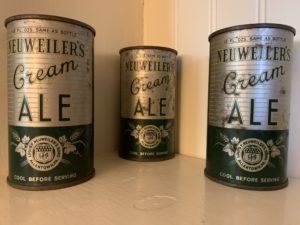My husband and I have lived in our house on Chamounix Road since 1988, longevity that might make us historic. Thirty years in the same house means we’ve updated and renovated four times since we moved in, changing the footprint of our 1912 home and leaving a contemporary mark that, one day, may be evident only by comparing the series of architectural drawings on file with Radnor Township. In other words, though we’ve lived here long enough to lay claim to this space, we are merely the most recent residents. The artifacts we’ve recovered over the years–a wooden clothespin, a calling card, a handmade gaming dice, the original knob-and-tube wiring that still, surprisingly, powers half the house–remind us that other people, now gone, lived here, too.
Artifacts tell stories–including the story of the person or persons who guzzled three Neuweiler’s Cream Ales in our attic and tossed the empties into the rafters around 1938. Just a few years before, beer would have been bottled. Canned beer was introduced in 1935, sealed in uncrushable metal (recyclable aluminum came later, in 1959) lined with a plastic called vinylite that was patented in 1936 as “Keglined.” The can itself heralds these innovations, conveying anxiety and its antidote in advertising copy: “Now packed in this modern container for your benefit.” An illustration of the “Canco quick and easy opener” you could “procure from your dealer” reminds us that the pop-top can we take for granted today was still 25 years in the future.
Neuweiler’s Sons in Allentown, Pennsylvania, was founded by German immigrant Louis Neuweiler in 1913. His son Charles–one of 16 children!–took over in 1929 and, according to family legend, turned down an offer from gangster/bootlegger Arthur Flegenheimer, aka Dutch Schultz, to buy the brewery. Though Neuweiler’s stopped producing in 1968, the 200,000-square-foot North Front Street complex has been added to the National Register of Historical Places, and is currently under development as a mixed-used commercial or office building by the Brewers Hill Group.
My research down a rabbit hole of microscopic manufacturer’s codes printed on the can, just beneath the patent, helped me to date the Neuweiler’s empties in my attic to 1937-38.
At that time, our house was in limbo; Fidelity Trust had foreclosed on mortgage holders David R. and Beatrice Shelmire, who were renting a room in a house in Ardmore by 1940, when the house was sold at auction. Financial despair and secret drinking in the attic? End-of-shift refreshment for a carpenter hired to fix the roof before the sale? I can only speculate. We have since expanded and transformed the dark and cramped attic into a sunny guest room, erasing the impressions left by those long-ago residents. Writing this account is my way of keeping a fragment of our house’s long history.
This story was contributed by Elizabeth Mosier

